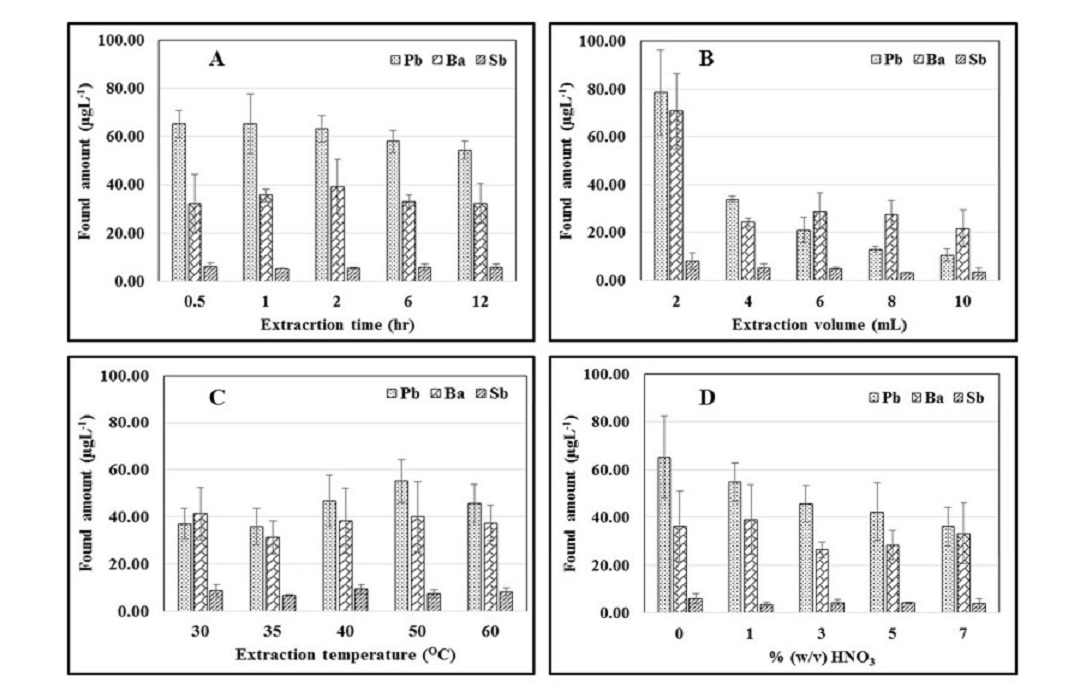Simple and Sensitive Method for Sampling, Extraction and Determination of Lead Barium and Antimony in Gunshot Residue Samples
DOI:
https://doi.org/10.14456/nujst.2023.40Keywords:
Sampling, Extraction, GSRs, GFAAS and Firing timeAbstract
The determination of elements typically found in gunshot residues (GSRs) such as Lead (Pb), Barium (Ba) and Antimony (Sb) plays an important role in the forensic investigation of firearm-related events. The present work developed a simple and highly sensitive method for sampling, extraction and determination of those elements by Graphite Furnace Atomic Absorption Spectrometry (GFAAS). The factors that might influence the efficiency of the sampling and extraction were investigated. The studied results showed that 100 µL of 5% HNO3 was sufficient for a single cotton swabbing. The extraction of Pb Ba and Sb was performed by using 1% HNO3 for 30 min at room temperature. The figures of merit from the proposed method in aqueous solution and optimum conditions presented a highly sensitive of 1.31, 3.70 and 0.42 µg L-1 limit of detection and high accuracy of 99.48±3.02%, 99.42±6.15% and 97.21±3.90% of recovery for the determination of Pb, Ba and Sb in GSRs, respectively. The proposed method was applied for the forensic study. Under optimal sampling and extraction conditions, the GSR samples on the back of the hands of the shooter after shooting at various times were determined by GFAAS. Friedman and t-test statistical results showed that the amounts of all elements significantly decreased over time after firing and different cleaning conditions at a 95% confidence level. It was found that Pb, Ba and Sb from the hands after washing with tap water had been observed up to 3 hr after shooting. The developed sampling and extraction methods are beneficial and help to identify the criminals.
References
Brozek-Mucha, Z. (2014). On the prevalence of gunshot residue in selected populations – An empirical study performed with SEM-EDX analysis. Forensic Science International, 237, 46-52.
Feeney, W., Menking-Hoggatt, K., Vander Pyl, C., E. Ott, C. E., Bell, S., Arroyo, L., & Trejos, T. (2021). Detection of organic and inorganic gunshot residues from hands using complexing agents and LC-MS/MS. Analytical Methods, 13, 3024-3029. https://doi.org/10.1039/d1ay00778e
Li, X. (2021). Measurement of gunshot residues with inductively coupled plasma mass spectrometry from a 9 mm × 25 mm police revolver and 7.62 mm × 25 mm type 64 pistol. Microchemical Journal, 160, 1-6. https://doi.org/10.1016/j.microc.2020.105678
Lopez-Lopez, M., Delgado, J. J., & Garcia-Ruiz, C. (2013). Analysis of macroscopic gunshot residues by Raman spectroscopy to assess the weapon memory effect. Forensic Science International, 231, 1-5.
Mingchanid, P., & Kulnides, N. (2017). Study on Persistence of Gunshort Residue After Shooting From 9 mm Pistol on Back of Hands and Palms with Different Persistent Duration and Bullet Types. KKU Research Journal (Graduate Studies)KKU Res (GS), 17, 8-18.
Nantasitangkool, P., Kittirakshakula, N, Watcharayotinkul, W., Prongmanee, W., Lamdab, U., Sukhkhawuttigit, S., Muenkla H., Ratnarathorn N., Kumpoo R., Sihabunmak N. & Samransamruadkit, Z. (2020). Interlaboratory Comparison of Gunshot Residue Analysis. 17th IMEKO TC 10 and EUROLAB Virtual Conference “Global Trends in Testing, Diagnostics & Inspection for 2030”: Proceedings of an online international conference on 20-22 October 2020, (pp. 156-161). Dubrovnik, Croatia: International Measurement Confederation (IMEKO).
O' Mahony, A. M., Windmiller, J. R., Samek, I. A., Bandodkar, A. J., & Wang, J. (2012). “Swipe and Scan”: Integration of sampling and analysis of gunshot metal residues at screen-printed electrodes. Electrochemistry Communications, 23, 52-55.
Phermpornsagul, Y., Arepornrat, S., Palkawong Na Ayuthaya, W., & Khaenamkaew, P. (2020). A Comparative Study of SEM-EDX and ICP-MS Detection Based on Gunshot Residue Originated from AK-47 and M16 Rifles. American Journal of Applied Sciences, 17, 69-82. https://doi.org/10.3844/ajassp.2020.69.82
Polnparkh, U., Chimpalee, N., & Hintao, K. (2012). Comparison of Particles of Occupation Origins Residues and Lead-free Gunshot Residues. KKU Research Journal (Graduate Studies), KKU Res (GS), 12, 34-45.
Polovkova, J., Simonic, M., & Szegenyi I. (2015). Study of gunshot residues from Sintox® ammunition containing marking substances. Egyptian Journal of Forensic Sciences, 5 (4), 174-179.
Romolo, F. S., & Margot, P. (2001). Identification of gunshot residue: a critical review. Forensic Science International, 119, 195-211.
Romolo, F. S., Christopher, M. E., Donghi, M., Ripani, L., Jeynes, C., Webb, R. P., …Ward N. I., Kirkby K. J. & Bailey, M. J. (2013). Integrated Ion Beam Analysis (IBA) in Gunshot Residue (GSR) characterization. Forensic Science International, 231, 219-228.
Salles, M. O., Naozuka, J., & Bertotti, M. (2012). A forensic study: Lead determination in gunshot residues. Microchemical Journal, 101, 49-53.
Tarifa, A., & Almirall, J. R. (2015). Fast detection and characterization of organic and inorganic gunshot residues on the hands of suspects by CMV-GC–MS and LIBS. Science and Justice, 55, 168-175.
Turillazzi, E., Paolo Di Peri, G., Nieddu, A., Bello, S., Monaci, F., Neri, M., …Pomara C., Rabozzi R., Riezzo I. & Fineschi, V. (2003). Analytical and quantitative concentration of gunshot residues (Pb, Sb, Ba) to estimate entrance hole and shooting-distance using confocal laser microscopy and inductively coupled plasma atomic emission spectrometer analysis: An experimental study. Forensic Science International, 231, 142-149.
Vanini, G., Destefani, C. A., Merlo, B. B., Carneiro, M. T. W. D., Filgueiras, P. R., Poppi, R. J. & Romao W. (2015). Forensic ballistics by inductively coupled plasma-optical emission spectroscopy: Quantification of gunshot residues and prediction of the number of shots using different firearms. Microchemical Journal, 118, 19-25.
Vanini, G., Souza, M. O., Carneiro, M. T. W. D., Filgueiras, P. R., Bruns, R. E., & Romao, W. (2015). Multivariate optimisation of ICP OES instrumental parameters for Pb/Ba/Sb measurement in gunshot residues. Microchemical Journal, 120, 58-63.
Yanez, J., Farías, M. P., Zuniga, V., Soto, C., Contreras, D., Pereira, E., …Mansilla H. D., Saavedra R., Castillo R. & Saez, P. (2012). Differentiation of two main ammunition brands in Chile by Regularized Discriminant Analysis (RDA) of metals in gunshot residues. Microchemical Journal, 101, 43-48.

Downloads
Published
How to Cite
Issue
Section
License
Copyright (c) 2023 Naresuan University Journal: Science and Technology (NUJST)

This work is licensed under a Creative Commons Attribution-NonCommercial 4.0 International License.













